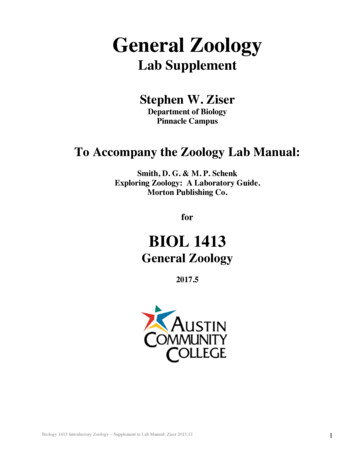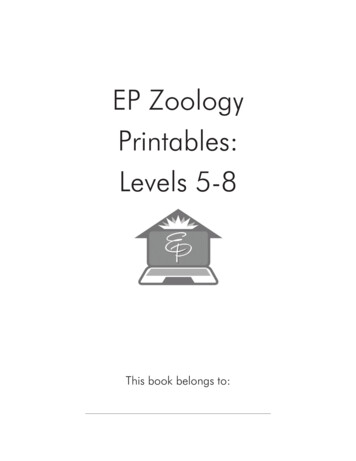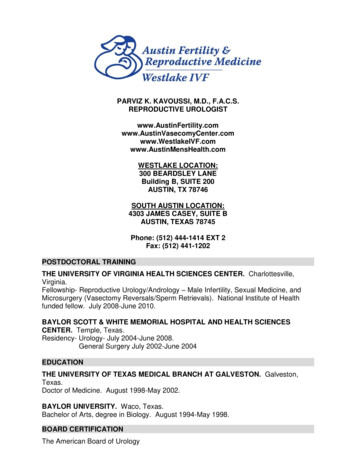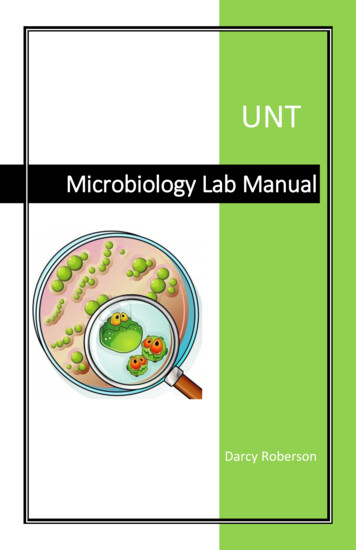
Transcription
General ZoologyLab SupplementStephen W. ZiserDepartment of BiologyPinnacle CampusTo Accompany the Zoology Lab Manual:Smith, D. G. & M. P. SchenkExploring Zoology: A Laboratory Guide.Morton Publishing Co.forBIOL 1413General Zoology2017.5Biology 1413 Introductory Zoology – Supplement to Lab Manual; Ziser 2015.121
General ZoologyLaboratory Exercises1. Orientation, Lab Safety, Animal Collection . . . . . . . . . . . . . . . . .32. Lab Skills & Microscopy . . . . . . . . . . . . . . . . . . . . . . . . 143. Animal Cells & Tissues . . . . . . . . . . . . . . . . . . . . . . . . . 154. Animal Organs & Organ Systems . . . . . . . . . . . . . . . . . . . . . 175. Animal Reproduction . . . . . . . . . . . . . . . . . . . . . . . . . . 256. Animal Development . . . . . . . . . . . . . . . . . . . . . . . . . . 277. Some Animal-Like Protists . . . . . . . . . . . . . . . . . . . . . . . . 318. The Animal Kingdom . . . . . . . . . . . . . . . . . . . . . . . . . . 339. Phylum Porifera (Sponges) . . . . . . . . . . . . . . . . . . . . . . . . 4710. Phyla Cnidaria (Jellyfish & Corals) & Ctenophora . . . . . . . . . . . . . 4911. Phylum Platyhelminthes (Flatworms) . . . . . . . . . . . . . . . . . . . 5212. Phylum Nematoda (Roundworms) . . . . . . . . . . . . . . . . . . . . 5613. Phyla Rotifera . . . . . . . . . . . . . . . . . . . . . . . . . . . . . . 5914. Acanthocephala, Gastrotricha & Nematomorpha . . . . . . . . . . . . . . 6015. Phylum Mollusca (Molluscs) . . . . . . . . . . . . . . . . . . . . . . . 6716. Phyla Brachiopoda & Ectoprocta . . . . . . . . . . . . . . . . . . . . . 7317. Phylum Annelida (Segmented Worms) . . . . . . . . . . . . . . . . . . . 7418. Phyla Sipuncula . . . . . . . . . . . . . . . . . . . . . . . . . . . . . 7819. Phylum Arthropoda (I): Trilobita, Myriopoda . . . . . . . . . . . . . . . 7920. Phylum Arthropoda (II): Chelicerata . . . . . . . . . . . . . . . . . . . 8121. Phylum Arthropods (III): Crustacea . . . . . . . . . . . . . . . . . . . 8622. Phylum Arthropods (IV): Hexapoda . . . . . . . . . . . . . . . . . . . . 9023. Phyla Onycophora & Tardigrada . . . . . . . . . . . . . . . . . . . . . 9724. Phylum Echinodermata (Echinoderms) . . . . . . . . . . . . . . . . . . .10425. Phyla Chaetognatha & Hemichordata . . . . . . . . . . . . . . . . . . . 10826. Phylum Chordata (I): Lower Chordates & Agnatha . . . . . . . . . . . . . 10927. Phylum Chordata (II):Chondrichthyes & Osteichthyes . . . . . . . . . . 11228. Phylum Chordata (III): Amphibia29. Phylum Chordata (IV): Reptilia .30. Phylum Chordata (V): Aves . . .31. Phylum Chordata (VI): Mammalia. 115. 118. 121. 124Lab Reports & AssignmentsIdentifying Animal Phyla . . . . . . . . . .Identifying Common Freshwater Invertebrates .Lab Report for Practical #1 . . . . . . . . .Lab Report for Practical #2 . . . . . . . . .Identification of Insect Orders . . . . . . . .Lab Report for Practical #3 . . . . . . . .Lab Report for Practical #4 . . . . . . . .Biology 1413 Introductory Zoology – Supplement to Lab Manual; Ziser 2015.12. 39. 42. 43. 62. 96. 98. 1302
Biol 1413 Lab OrientationThe laboratory portion of this course is designed to study anatomical details of of animals in general orcommon examples of specific phyla more thoroughly than it is presented in lecture. This method of‘hands on’ learning should also enhance and strengthen the knowledge you gain in lectures. Most ofthe time you will be working individually or in pairs.There is sometimes not enough time in lab to go over each and every item that you are assigned. Thelab is a designated a time when you have access to materials that you will not have available duringhome study time. Some of the information assigned in lab you can learn at home, other items,particularly anatomical terms identified on dissected organs, animals and models and microscopicdetails viewed with a microscope can only be learned adequately in the lab room.The lab period will begin with a short introduction and orientation to the material to be studied. I willassume that you have read the exercise before you come to lab. I will point out which models,preserved animals and slides we have available for the lesson as well as any changes to the procedures.The rest of the lab time is yours to begin learning the material, view any assigned slides and performany dissections that are required.All dissecting tools will be provided for you, you do not need to buy a dissecting kit. We have a smallsupply of latex gloves available for the dissections.Biology 1413 Introductory Zoology – Supplement to Lab Manual; Ziser 2015.123
Lab ReportsEach student will complete a Lab Report (see Table of Contents)for the material covered in each of 4Lab Practicals. Lab reports are at the end of each section of material for each practical (see Table ofContents).Each lab report will include answers to specific questions from individual lab activities as well asgeneral questions about the animal kingdom. You will also be asked to make sketches and observationsabout the slides and preserved materials that you are studying. You are also free to include any othermaterials (see below) that you think might be helpful to learn the information presented in the labexercises and prepare yourself for the practical.These Lab Reports will be due on the day of the practical covering the same material.Drawings:1. If you are sketching material without magnifcation or if you are switching back and forthbetween no magnification and slight magnification (eg. hand lens)you should draw a rectangularborder around your sketch and indicate the actual size of the object being sketched.2. if you are sketching material viewed through a microscope or a dissecting scope, trace acircular border in which to make your drawing (You might cut out a cardboard circle to useeach time so they will be neatly done and all the same size). Make sure your drawing fills thecircle to the same extent that the object actually appears through the microscope. Be sure toindicate the magnification being used for each sketch3. More detailed information on drawing techniques can be found in the “Collecting and PreservingMethods” binder on the lab counter. If you want to try these more detailed directions, I’ll behappy to make you a copy of the articleWhat else you might want to include:§§§§Sketches of slide materials, models or preserved materials that will help you to study for thepracticals. Any sketches should be labeled appropriatelyYou might also want to include comments on the appearance or difficulty in finding and/oridentifying the materials for studyAny personal observations you made while completing the exercise or studying the materialSpecial points to be aware of while reviewing the labRemember that the function of these reports should be to help you organize your lab material and tofacilitate learning it for the practical.Biology 1413 Introductory Zoology – Supplement to Lab Manual; Ziser 2015.124
General Zoology Animal CollectionYou will make a small animal collection consisting of 5 different animals, from 5 different phyla orsubphyla. You will NOT get these items back so please don’t include a keepsake or treasure that youwant to hold onto. ACC will provide nets, vials, jars, preservative, insect pins, some labels, etc. Thegoals for this collection are to:ØØØØØLearn to visually recognize some of the animals common to the areaLearn something about the ecology and behavior of these animalsLearn how to use identification manuals and keysBecome acquainted with the taxonomy and classification of animals, andLearn how to properly preserve and label museum specimensYou will be given more information on proper preservation and presentation of specimens in lab. Youmight also want to consult some Identification keys for the kinds of animals that you are interested incollecting. The animal collection will be worth 50 points and is due the Monday of the last week ofclasses.Your grade for the collection will be based on the following criteria:Ø diversity and originality of your collectionØ ability to follow correct procedures for preserving and displaying specimensas described in thematerialsØ quality of the preservation techniqueØ accuracy of identification (usually to species) & common nameYou do not need to kill anything to make this collection. Some examples of the kinds of collections youcan make:soil and leaf litter organismsaquatic organismsshellsskeletons and/or skullsnests, burrows, tunnels, etcplaster casts of footprints or tracksphotographsparasitesfossilsThe preservation method that you choose depends on the type of collection that you do. For example:Permanent Slides:are used for small or microscopic animals70% alcohol/10% formalin: is used for most invertebrates including insect larvae, larger invertebrates andsome vertebrates will need to be injectedStudy Skins:for birds and mammalsDried Specimens:for bones, shells, nests, etcPinned Specimens:adult insects are generally dried on insect pins and mounted in an insect boxEach and every specimen must be properly labeled. The type and location of the label depends on thekind of collection and preservation that you do. All labels must include the following information:Collection Locality (including nearest city)General Habitat (eg. woods, pond, soil, treebark, grass, etc)Scientific Name & Common NameYour NameDate of collectionWhen in doubt ASK THE INSTRUCTOR.Biology 1413 Introductory Zoology – Supplement to Lab Manual; Ziser 2015.125
Animals Preserving TechniquesA Shortened Summary(More detailed instructions and suggestions can be found in the "ZOOLOGY ANIMAL COLLECTION AND TECHNIQUES" binder in 701)We can provide containers, vials or bags along with preservatives for your collection.We have several dozen identification guides for many kinds of central Texas animals. You can alsofind ID guides at the PIN Library and most public libraries in Austin. You can also find quite a lotof information by searching the webMore information on proper collecting and preserving techniques are in a binder in the labroom .More detailed Information on preserving various kinds of specimens:A. Animals collected live:Most invertebrates except those listed below:Kill and preserve in jars of 10% formalin solution or 70% alcohol (ethyl or isopropyl; make label withIndia ink and place inside jarMost insects except butterflies, moths and dragonflies:Kill in killing jar or freezer; pin properly; allow to dry; label should be no larger than 1"x1/2" and placedon pin below insectButterflies, moths and dragonflies:Kill in killing jar or freezer; pin and arrange wings on spreading board or piece of styrofoam; allow to dry;label should be no larger than 1"x1/2" and placed on pin below insectVertebrates except for birds and mammals (e.g.: fish, frogs, salamanders, lizards, snakes, turtles)kill in freezer; fix and preserve in jar of 10% formalin solution; use syringe to inject formalin solution intothe body cavity in several places; make label with India ink and place inside jarBirds and Mammals:Hunt following all applicable state and federal laws; prepare a "study skin" using the techniques outlinedin the 'ZACT' manual mentioned above; a label no larger than 1"x3" is attached by string to rear legB. Animals collected dead but in good condition:Most invertebrates and lower vertebrates:Preserve in jars of 10% formalin solution or 70% alcohol; label as aboveInsects:If they are freshly dead, use above procedures; if they are long dead and dried out you will need to placethem in a "relaxing chamber" to soften them up so they can be pinned and arranged; label as aboveBiology 1413 Introductory Zoology – Supplement to Lab Manual; Ziser 2015.126
Birds and Mammals:"roadkills" in good condition can be skinned and study skins prepared as aboveSkull or Skeletal mounts:Flesh can be removed by several means such as boiling, staking near fireant hill or using dermestedbeetles; once bones are defleshed they can be placed in a bleach or hydrogen peroxide solution to whiten;allow to dry; place in bag or box with complete label tied to skull if possibleC. Nests, Feathers, Eggs, Racks, shells, feathers:Clean up as much as possible and place in bag or box with complete labelD. Footprints and Burrows:Use plaster of Paris to pour into print, allow to set then remove and clean off; place in bag or box withlabelE. Photographs:Should be original photographs; most 'good' photographs will need a telephoto lens for vertebrates orclose-up lenses for small invertebrates and insects - the specimen should take up a substantial part of theframe and be easily recognizableBiology 1413 Introductory Zoology – Supplement to Lab Manual; Ziser 2015.127
Biology Lab Safety Procedures and InformationHealth and safety are paramount values in science classrooms, laboratories and fieldactivities. You are expected to learn, understand and comply with ACC environmental, healthand safety procedures and agree to follow the ACC science safety policy. You are expected toconduct yourself professionally with respect and courtesy to all. You can read the completeACC science safety policy at: http://www.austincc.edu/sci safe/All safety policies and procedures apply to scheduled lab classes as well as open labs.Consequences for not complying with safety procedures:1. You will not be able to participate in a lab activity if:a. you are late for class and have missed safety training specific for that day’s labor field activity;b. you have forgotten your personal protective equipment;c. you refuse to wear personal protective equipment;d. you have not followed safety policies and procedures for that lab or field activity.2. You may be withdrawn from the class and not reinstated if:a. you missed required safety training at the beginning of the semester;b. you repeatedly fail to follow lab safety policies and procedures.3. You may be expelled from ACC if you thoughtlessly or intentionally jeopardize the health orsafety or another individual.EmergenciesIf there is a life-threatening emergency (fire, major chemical spill, explosion, injury):1. Report the situation and your specific location (campus, room) byusing the safety phone in a lab classroom; it will automatically connect you to ACCPolice Dispatch (location of safety phonecalling 222 from any ACC phone to reach ACC Police Dispatchcalling 512-223-7999 from a cell phone or non-ACC phone to reach ACC PoliceDispatch2. Evacuate if necessary:a. take your personal belongings with you if possible;b. on your way out, close but do not lock the classroom door;c. go to the designated rally point for your campus and building.Directions to nearest exit:Location of rally point:In the event of an extreme emergency or impending threat, ACC Emergency Alert can sendcritical voice and text messages to your cellphone. Verify and update your ACC EmergencyAlert information. For non-emergency calls, dial 512-223-1231.Safety Equipment and How to Use It:à Information about chemicals used in this laboratory can be found in Material SafetyData Sheets (MSDSs) and in a chemical inventory located .à The emergency gas shut-off for this lab is located: . Shutoff the gas immediately if gas nozzles or valves are damaged or if there is a fire.à Fire extinguishers are located:(1) .(2) .To use a fire extinguisher:1) twist the pin and then pull it out of the handle2) hold the end of the hose and point it at the base of the fireBiology 1413 Introductory Zoology – Supplement to Lab Manual; Ziser 2015.128
3) squeeze the handleà Fire blankets are located:(1) .(2) .If you are on fire, stop, drop and roll. Let someone else to get the fire blanket.à A safety shower is located . Ifyou spill a significant quantity of chemical, especially an acid or base on yourselfimmediately stand under the shower and pull the handle. Disrobe. The instructorwill evacuate the room and close the doors for your privacy. Someone of yourgender will stay to help you. Stand under the shower for at least 20 minutes. Youwill be given clothing after the shower.à An eyewash is located . If a chemical issplashed or rubbed into your eyes you must use an eyewash for at least 20minutes with your eyes held open. Someone will help you with this.à If a person is experiencing electrical shock from touching wires or equipment, use abelt or other non-conducting material to pull them away from the electrical source.à First aid kits are located:(1) .(2) .a. Only minor cuts and burns will be treated in the lab. Serious injuries must betreated in a medical facility. Emergency Medical Services (EMS) will becalled if you are injured and are unable to take yourself to a medical facility.b. The instructor must fill out a report describing your injury.Personal Protective Equipment (PPE)1. Required when biological, chemical or physical hazards are present on the labbenches, open shelves or counters:a. Safety Eyewear*You must wear non-tinted safety eyewear (safety glasses or goggles)marked Z87 when directed to do so by the lab instructor or lab safetyinstructions.*You must bring your protective eyewear with you to every lab class. If youforget your eyewear and the lab room does not have a pair to loan to you,you will not be able to participate in the lab and may forfeit your lab grade forthat day. ACC cannot guarantee that loaned safety glasses or safetygoggles are uncontaminated by microbes or chemicals.*People who wear contact lenses must wear goggles and may not wear safetyglasses.b. Gloves – You will be provided with nitrile gloves for handling biohazards andhazardous chemicals.Please notify the instructor if your skin is irritated bythese gloves.c. Shoes – Shoes must cover the top, front and sides of your feet. They must beimpervious to liquids.d. More specific requirements may exist for labs in which unique hazards are present(for example: BSL2 organisms or physical hazards such as sharps, open flame,UV light, pressurized gases, or liquid nitrogen.2. Recommended when biological, chemical or physical hazards are present on the labbenches, open shelves or counters:a. Apron or Lab Coat – You may be instructed to wear an apron or lab coat over yourclothes when handling biohazards or hazardous chemicals.b. Wear natural fiber clothing for any lab activity involving open flame (synthetic materialBiology 1413 Introductory Zoology – Supplement to Lab Manual; Ziser 2015.129
melts onto skin in a fire).c. Before putting on gloves remove watches, rings, and bracelets that could eitherpuncture the glove from the inside or interfere with rapid removal of the gloves.d. Tie back long hair. e. Do not wear clothing with long, loose sleeves.Waste DisposalYou must precisely follow the waste disposal procedures. Never dispose of anything in labwithout prior direction from the instructor.à Hazardous chemical waste containers are located:solidsliquidsà Biohazard bags are located: àSharps containers are located: à Glass(rinsed test tubes and broken glass) disposal boxes are located:à Regular trash containers are located:Lab Conduct1) At the beginning of any class held in a lab room, do not enter the room until your instructoris present. Wait in the hall, even if the door is open.2) Do these things:*follow all procedures in manuals, in handouts, and as given by the instructor;*store backpacks, coats, and other personal items as directed;*report broken glass and chemical spills to your instructor immediately.3) Do NOT do these things:*come to class while intoxicated or while under the influence of drugs that impair yourability to safely perform the lab or field activity;*horse around or perform unauthorized experiments;*eat, drink, or chew (tobacco or gum);*bring drinks or food (even in closed containers) into the lab;*pipet by mouth; taste chemicals or directly smell chemical fumes.Lab Hygieneà Clean up your individual work area/equipment and community workareas/equipment (e.g., sinks, balances).à Put lids back on bottles and containers immediately after use.àDo not put excess chemicals back into original containers.à Dispose of chemicals and waste only as directed by the instructor.à Turn off equipment as instructed.à Wash your hands prior to leaving lab.à Assume that chemicals used in lab are corrosive or irritating. If at any timechemicals come into contact with your skin wash the affected area immediately.Standard / Universal PrecautionsDiseases such as HIV and hepatitis can be transmitted from person to person through contactwith human blood or other body fluids. Follow the Standard or Universal Precautionswhenever exposure to human body fluids is possible:à Consider all body fluids (saliva, blood, urine, feces, vomit) to be potentially infectedwith a harmful pathogen.Biology 1413 Introductory Zoology – Supplement to Lab Manual; Ziser 2015.1210
à Do not touch or come into contact with anyone else's body fluids.Student Accident InsuranceAll students enrolled in lab classes are covered by Student Accident Insurance that pays forinjuries occurring from school sponsored activities related to the class. It does not pay forillnesses such as allergies or the flu, or fainting.All faculty and students should read theguidelines at: th-safety-andinsurance/student- insurance. You can also download the claim form from this location.Chemical Hazard Labels*Label all containers and test tubes as directed.*Inform your instructor immediately if a label is damaged in any way.*Read all labels and pay special attention to hazard information.A typical chemical hazard label conveys two kinds of information: 1) the category of thehazard (flammable, toxic, reactive, or corrosive) and 2) the level of the hazard.There are three types of labels: 1) GHS (Globally Harmonized System - the internationalsystem of hazard identification), 2) diamond-shaped hazard labels, and 3) bar-shaped hazardlabels.GHS labels are found mostly on primary containers, the jars or packages in which thechemical manufacturer packaged the chemicals.The GHS system labels include icons thatwarn you about the major type or types of hazards associated with the chemical. (see nextpage)Most of the containers you use in lab are secondary containers such as flasks, test tubes,jars, and beakers. Secondary containers will have either the diamond shapes or the barshapes. In both of those labels the category of hazard is represented by a color and the levelof the hazard is represented by a number.1. Hazard categories are coded by color:2. Hazard level is coded by a number:3. Refer to the training poster in your lab for examples.Biology 1413 Introductory Zoology – Supplement to Lab Manual; Ziser 2015.1211
Other types of hazard warning labels you must recognize are:Biology 1413 Introductory Zoology – Supplement to Lab Manual; Ziser 2015.1212
Laboratory Safety & EquipmentFamiliarized yourself with the various supplies and equipmentin the labroom. Keep this sheetaccessible throughout the semester.Assume the blackboard is at the “front” of the room and the windows are on the “left” sideDescribe The Specific Locationof Eachlatex glovessafety glasses/goggleseyewash stationsinksdisinfectantspray bottlespaper towelsbiohazard bagglass disposal boxesdeionized waterspigotsfire extinguisherfirst aid kithazardous materialsspill kitdissecting kitsblank slides &coverslipsBiology 1413 Introductory Zoology – Supplement to Lab Manual; Ziser 2015.1213
Fundamental Lab Skills & Use of Microscopes(Smith & Schenk: Fundamental Laboratory Skills, Chapter 1)1. Body Symmetry, Body Planes and Body Regions [1st Ex 1-7; 2nd Ex 1-6]-familiarize yourself with the terms related to symmetry (assymetry, radial symmetry, bilateralsymmetry); planes of dissection (sagittal, transverse and frontal planes) and directionalterms (anterior – posterior, dorsal – ventral, medial – lateral, proxomal distal)2. Basic Dissection Techniques [1st Ex 1-6; 2nd Ex 1-5]-read closely the rules for basic dissection techniques; make sure you understand them3. The Compound Microscope [1st Ex 1-3; 2nd Ex 1-2]-familiarize yourself with the basic "anatomy" of the microscope and general functions of thefollowing parts: ocular, objectives, stage, mechanical stage, revolving nosepiece,condenser, illuminator, iris diaphragm, light switch, course & fine focusing knobs-be able to define magnification and determine the magnification produced by eachobjective-be able to find and focus on prepared slides at all magnifications from scanning to high power-be able to make "wet mounts" and find and focus at all magnifications [1st Ex 1-4; 2nd Ex 1-3]4. The Dissecting (Stereoscopic) Microscope [1st Ex 1-5; 2nd Ex 1-4]-familiarize yourself with the basic "anatomy" of the dissecting scope and general functions of thefollowing parts: eyepiece, magnification knob, stage, overhead & substage lightswitches,focusing knob-be able to focus, adjust the magnification, and adjust the light-know when it is best to use this scope as opposed to the compound microscopeAdditional Lab Report Suggestions:-Magnification of scanning, low and high power-Make some rough sketches of the things you view under both scopes, be sure to label each sketchand to indicate magnification used; note any unusual characteristics or features-If you want to experiment with different kinds of drawing techniques read reprint D in the ZoologyAnimal Collections and Lab Techniques folderBiology 1413 Introductory Zoology – Supplement to Lab Manual; Ziser 2015.1214
Animal Cells & Tissues(Smith & Schenk; Cells & Tissues, Chapter 2)I. Animal Cells [Ex 2-1]Procedure:1. General Features of Animal Cellsa. model: animal cell-observe the animal cell model and be able to identify the structures below:cell membrane, cytoplasm, nucleus, organelles, mitochondria, ribosomes,endoplasmic reticulumb. wet mount: cheek cell-prepare a wet mount of your cheek cells as instructed and identify all cellular structures visiblec. slide: unfertilized starfish eggs [Ex 2-1]2. List the major structures or organelles you found in the cell model and the general function of eachin the space provided in your lab report.II. Animal Tissues [Ex 2-2]Procedure:1. read introductory materials for general tissues and each of the 4 tissue types.2. Epithelial Tissues-line surfaces, both internal and external; function: protection, secretion, absorption, filtration;secrete cuticles, exoskeletons, shells, etc-tightly packed cellsa. slide: epithelium simple squamous oral smearslide: simple cuboidal epithelium (fig 2.3b)slide: epithelium columnar cell sec (fig 2.3c)- Observe and be able to recognize these slides as examples of squamous epithelial tissue3. Connective Tissues-support, storage, transport, protection-identified by its kind of matrix and fibers presenta. read the introduction for connective tissues in general and for each of the four specifickinds below.b. observe the 4 kinds of connective tissues below and be able to recognize them as types ofconnective tissues:Biology 1413 Introductory Zoology – Supplement to Lab Manual; Ziser 2015.1215
i. Areolar: slide: mammal areolar tissue spread (fig 2.9)-"glue" to hold other tissues togetherii. Adipose: slide: adipose tissue, sec (fig 2.8)-fat storageiii. Bone: slide: bone dry ground human cs (fig 2.7)-rigid supportiv. Vascular tissue: slide: frog blood smear (H.O.)-transport of nutrients, wastes, oxygen, hormones, etc4. Muscle Tissues-movement both internal and external, both voluntary and involuntary-elongated spindle-shaped cellsa. slide: skeletal muscle tissue teased (fig 2.13)-Recognize the slide below as an example of muscle tissue5. Nervous Tissues-conduct impulses (transmit information)-cells with large central area and several processes extending away from ita. slide: mammal motor neuron nerve cells smear (fig 2.15)-recognize the slide below as nervous tissue6. Make a sketch of one example of each of the four major animal tissue types in the space provided onyour lab reportAdditional Lab Report Suggestions:àhow difficult is it to distinguish between the different tissue typesàwhat are the common features of each major tissue typeà what are some of the major functions of each of the tissues you looked at?Biology 1413 Introductory Zoology – Supplement to Lab Manual; Ziser 2015.1216
Animal Organs and Organ SystemsOf all kingdoms of life, animals have achieved the greatest level of structural orgainization. Allanimals are multicellular. Most animals have organized these cells into discrete tissues with adistinctive structure and function. Also, most animals have used these tissues to construct variousorgans and organ systems to perform the common activities of life.Human Organ Systems Overviewa. Skeletal Systemeach individual bone is a separate organ of the skeletal system (eg. humerus,radius, femur, etc. )General Functions1.2.3.4.Support (particularly on land)Movement (along with muscular system)Protection of certain vital organs (eg. brain, heart, reproductive organs, etc)Mineral storage (eg. calcium & phosphorus)The skeletal system serves several important functions the most obvious of which are structuralsupport and protection of vital organs. The skeleton also serves as a reservoir for importantminerals such as calcium and phosphorus. In addition, red blood cells are produced in bonemarrow.Aquatic animals require little support against gravity but terrestrial animals have invented a varietyof support structures that not only counteract the forces of gravity but may play an important role inmovement as w
Biology 1413 Introductory Zoology - 4Supplement to Lab Manual; Ziser 2015.12 Lab Reports Each student will complete a Lab Report (see Table of Contents)for the material covered in each of 4 Lab Practicals. Lab reports are at the end of each section of material for each practical (see Table of










